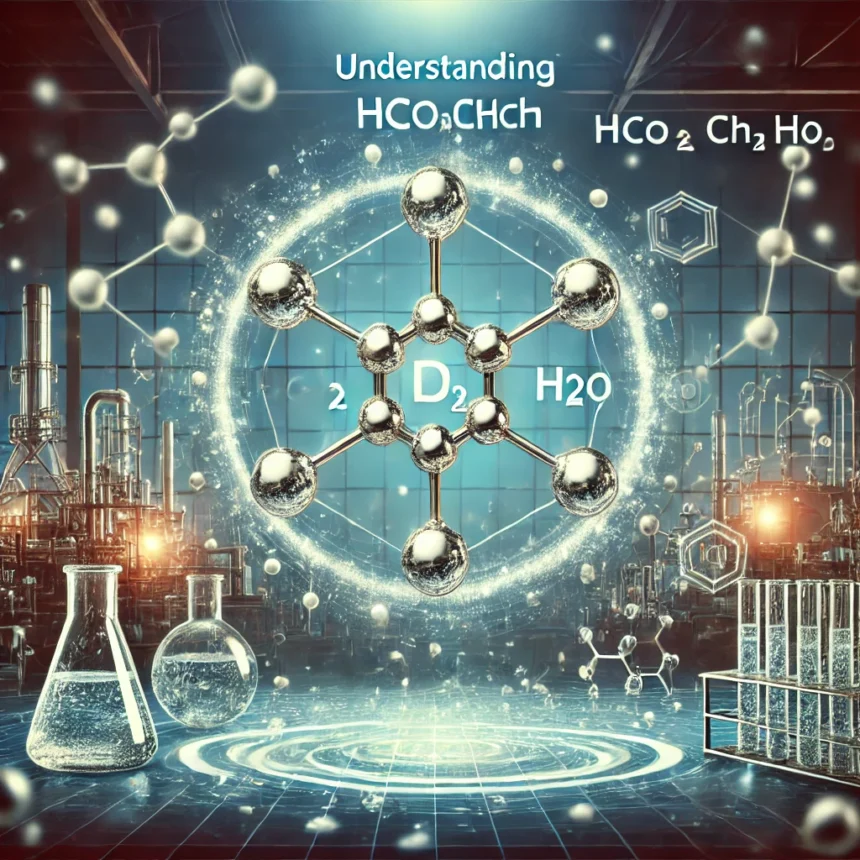HCOOCH CH2 H2O is a chemical formula that suggests a complex organic compound, potentially related to esters, alcohols, or hydrated organic molecules. Understanding its structure and significance is important in various scientific fields, including chemistry, pharmaceuticals, agriculture, and industrial applications. While this formula is not commonly found in mainstream chemical literature, breaking it down into its individual components can provide insights into its possible nature and functionality.
Chemical Composition and Structure
The formula HCOOCH CH2 H2O can be analyzed based on its individual elements and functional groups. The presence of HCOOCH suggests a possible formate ester or a derivative of formic acid. Esters are organic compounds formed from alcohols and acids, commonly used in organic synthesis and industrial applications. The CH2 group represents a methylene (-CH2-) unit, which is frequently found in hydrocarbons, alcohols, and other organic molecules. H2O represents water, which could indicate hydration or an aqueous form of the compound.
Considering these components, HCOOCH CH2 H2O could be a hydrated ester or a reactive intermediate in organic reactions. It might participate in hydrolysis, where water interacts with esters to form alcohols and acids. In some cases, such compounds play a role in biochemistry, particularly in metabolic pathways involving carboxylate and formate derivatives.
Industrial and Chemical Applications
If HCOOCH CH2 H2O represents an ester or similar organic compound, it is likely to be useful in several industrial processes. Esters are commonly employed in the production of fragrances, solvents, and resins. Additionally, they serve as intermediates in chemical manufacturing, where they contribute to the formation of other valuable compounds.
In the pharmaceutical industry, esters are frequently used in drug formulations. Many active pharmaceutical ingredients (APIs) are synthesized using esterification reactions, and some ester-based drugs rely on hydrolysis in the body to release their active form. If HCOOCH CH2 H2O has similar properties, it might be involved in drug development or biomedical research.
Another possible application is in the production of biodegradable solvents. Many modern industries seek environmentally friendly alternatives to traditional solvents, and esters are a popular choice due to their lower toxicity and biodegradability. HCOOCH CH2 H2O, if confirmed as an ester-based compound, could have potential as a green solvent in industrial and laboratory settings.
Agricultural and Environmental Impact
Organic compounds containing formate or ester groups can also have agricultural applications. Some esters and related compounds are used in pesticides, herbicides, and fertilizers. Their ability to break down in the environment makes them preferable to some synthetic alternatives, which may persist in soil and water.
Additionally, the presence of water (H2O) in the formula suggests that this compound could exist in a hydrated or aqueous state. In agriculture, water-soluble esters are sometimes used as plant growth regulators or as carriers for active ingredients in fertilizers. Understanding the solubility and reactivity of HCOOCH CH2 H2O would be essential for evaluating its role in agricultural chemistry.
From an environmental perspective, esters and formate-based compounds are often biodegradable, meaning they do not accumulate in ecosystems. However, their impact on soil and water quality would need to be studied further. If this compound is used in industrial or agricultural settings, proper disposal methods should be established to minimize any environmental risks.
Role in Biochemistry and Organic Synthesis
Many organic compounds, including esters, play crucial roles in biochemical pathways. In living organisms, esters participate in lipid metabolism, energy production, and enzyme-catalyzed reactions. If HCOOCH CH2 H2O resembles a naturally occurring metabolite, it could be relevant in biochemical research.
Furthermore, esters are widely used in laboratory organic synthesis. They serve as intermediates in reactions such as transesterification, where an ester is converted into another ester through the exchange of organic groups. This process is important in the production of biodiesel and other industrial chemicals.
If HCOOCH CH2 H2O has similar properties, it could be a valuable compound for researchers working on synthetic chemistry. Studying its reactivity, stability, and potential interactions with other organic molecules would help determine its practical applications.
Read also: Explore the World with HopTraveler.com: Your Ultimate Travel Companion
Conclusion
HCOOCH CH2 H2O appears to be a complex organic compound with potential applications in chemistry, industry, and agriculture. While its exact identity and properties require further study, its components suggest that it could be a formate ester, a hydrated organic molecule, or a reactive intermediate in synthesis.
Understanding its structure and reactivity is crucial for exploring its full range of applications. Whether it is used in pharmaceuticals, green solvents, agriculture, or industrial synthesis, HCOOCH CH2 H2O could have significant scientific and practical relevance. Ongoing research and chemical analysis will be necessary to confirm its identity and unlock its potential in various fields.






